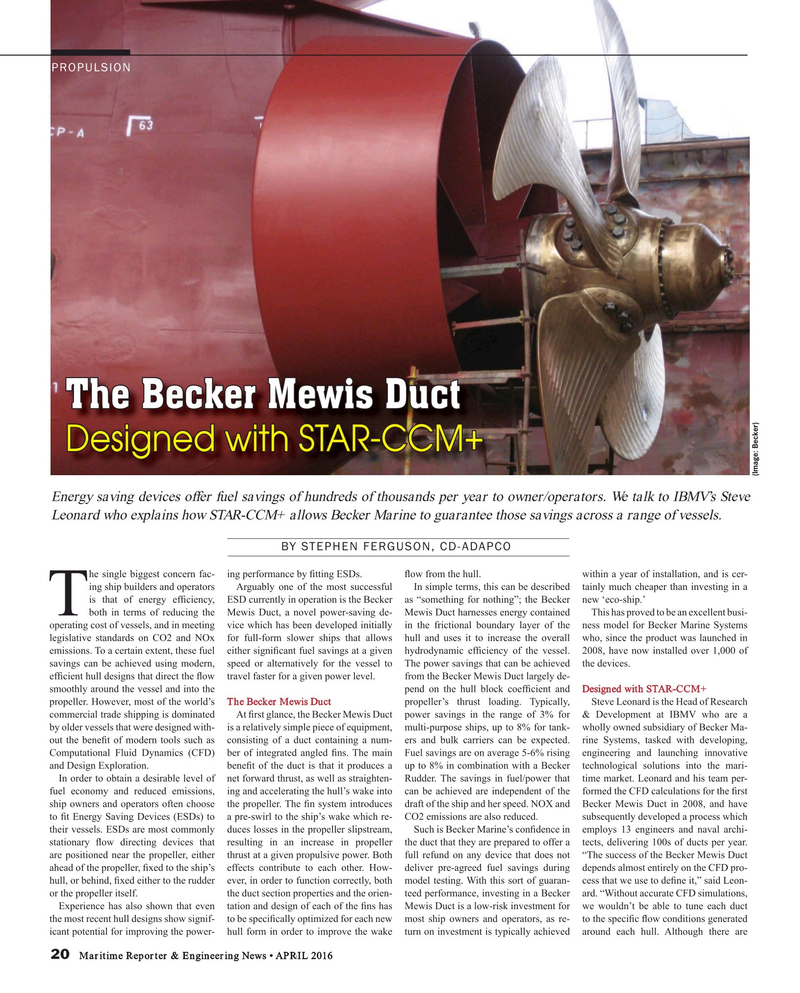
Page 20: of Maritime Reporter Magazine (April 2016)
The Offshore Annual
Read this page in Pdf, Flash or Html5 edition of April 2016 Maritime Reporter Magazine
PROPULSION
The Becker Mewis DuctThe Becker Mewis Duct
Designed with STAR-CCM+Designed with STAR-CCM+ (Image: Becker)
Energy saving devices offer fuel savings of hundreds of thousands per year to owner/operators. We talk to IBMV’s Steve
Leonard who explains how STAR-CCM+ allows Becker Marine to guarantee those savings across a range of vessels.
BY STEPHEN FERGUSON, CD-ADAPCO he single biggest concern fac- ing performance by ? tting ESDs. ? ow from the hull. within a year of installation, and is cer- ing ship builders and operators Arguably one of the most successful In simple terms, this can be described tainly much cheaper than investing in a is that of energy ef? ciency, ESD currently in operation is the Becker as “something for nothing”; the Becker new ‘eco-ship.’
Tboth in terms of reducing the Mewis Duct, a novel power-saving de- Mewis Duct harnesses energy contained This has proved to be an excellent busi- operating cost of vessels, and in meeting vice which has been developed initially in the frictional boundary layer of the ness model for Becker Marine Systems legislative standards on CO2 and NOx for full-form slower ships that allows hull and uses it to increase the overall who, since the product was launched in emissions. To a certain extent, these fuel either signi? cant fuel savings at a given hydrodynamic ef? ciency of the vessel. 2008, have now installed over 1,000 of savings can be achieved using modern, speed or alternatively for the vessel to The power savings that can be achieved the devices.
ef? cient hull designs that direct the ? ow travel faster for a given power level. from the Becker Mewis Duct largely de- smoothly around the vessel and into the pend on the hull block coef? cient and Designed with STAR-CCM+ propeller. However, most of the world’s The Becker Mewis Duct propeller’s thrust loading. Typically, Steve Leonard is the Head of Research commercial trade shipping is dominated At ? rst glance, the Becker Mewis Duct power savings in the range of 3% for & Development at IBMV who are a by older vessels that were designed with- is a relatively simple piece of equipment, multi-purpose ships, up to 8% for tank- wholly owned subsidiary of Becker Ma- out the bene? t of modern tools such as consisting of a duct containing a num- ers and bulk carriers can be expected. rine Systems, tasked with developing,
Computational Fluid Dynamics (CFD) ber of integrated angled ? ns. The main Fuel savings are on average 5-6% rising engineering and launching innovative and Design Exploration. bene? t of the duct is that it produces a up to 8% in combination with a Becker technological solutions into the mari-
In order to obtain a desirable level of net forward thrust, as well as straighten- Rudder. The savings in fuel/power that time market. Leonard and his team per- fuel economy and reduced emissions, ing and accelerating the hull’s wake into can be achieved are independent of the formed the CFD calculations for the ? rst ship owners and operators often choose the propeller. The ? n system introduces draft of the ship and her speed. NOX and Becker Mewis Duct in 2008, and have to ? t Energy Saving Devices (ESDs) to a pre-swirl to the ship’s wake which re- CO2 emissions are also reduced. subsequently developed a process which their vessels. ESDs are most commonly duces losses in the propeller slipstream, Such is Becker Marine’s con? dence in employs 13 engineers and naval archi- stationary ? ow directing devices that resulting in an increase in propeller the duct that they are prepared to offer a tects, delivering 100s of ducts per year. are positioned near the propeller, either thrust at a given propulsive power. Both full refund on any device that does not “The success of the Becker Mewis Duct ahead of the propeller, ? xed to the ship’s effects contribute to each other. How- deliver pre-agreed fuel savings during depends almost entirely on the CFD pro- hull, or behind, ? xed either to the rudder ever, in order to function correctly, both model testing. With this sort of guaran- cess that we use to de? ne it,” said Leon- or the propeller itself. the duct section properties and the orien- teed performance, investing in a Becker ard. “Without accurate CFD simulations,
Experience has also shown that even tation and design of each of the ? ns has Mewis Duct is a low-risk investment for we wouldn’t be able to tune each duct the most recent hull designs show signif- to be speci? cally optimized for each new most ship owners and operators, as re- to the speci? c ? ow conditions generated icant potential for improving the power- hull form in order to improve the wake turn on investment is typically achieved around each hull. Although there are 20 Maritime Reporter & Engineering News • APRIL 2016
MR #4 (18-25).indd 20 MR #4 (18-25).indd 20 4/6/2016 5:30:42 PM4/6/2016 5:30:42 PM

 19
19

 21
21
